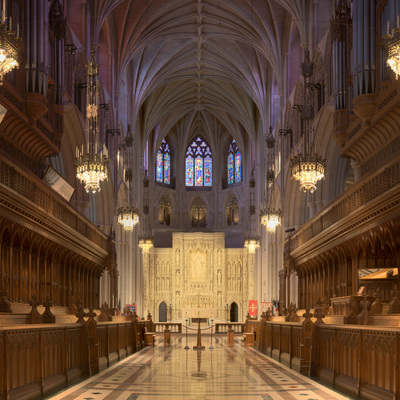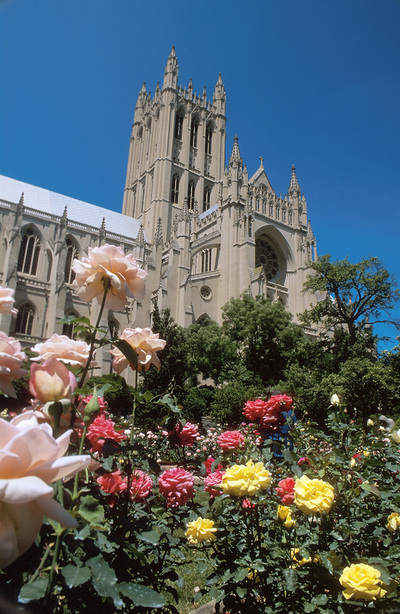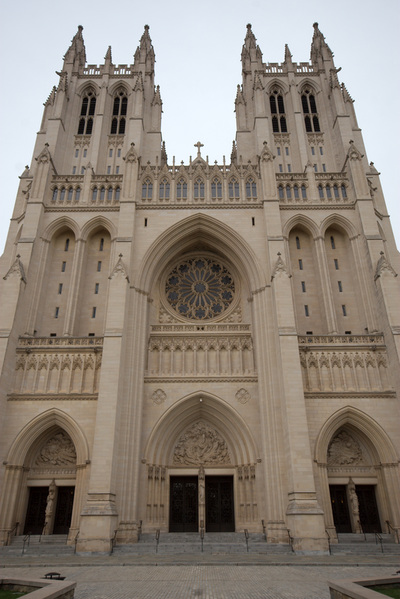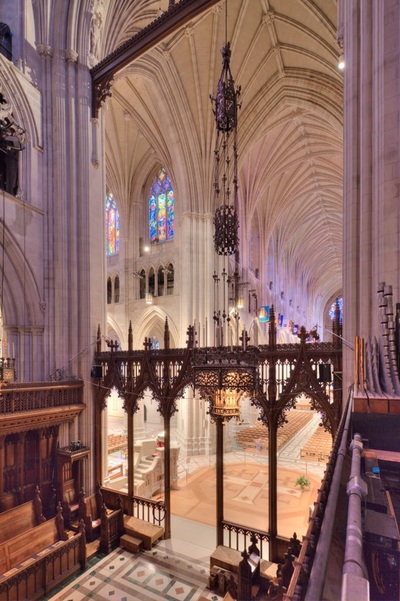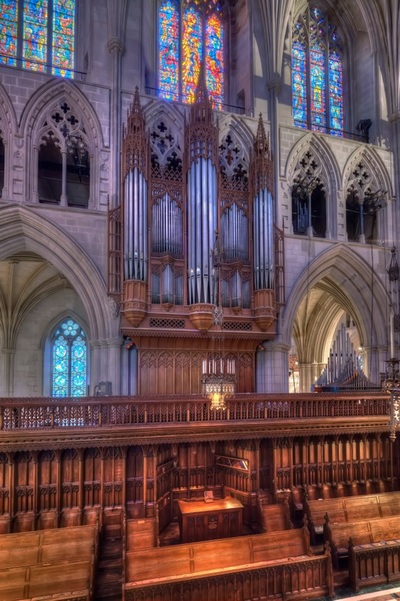WASHINGTON NATIONAL CATHEDRAL
The Great Organ of Washington National Cathedral was built by the Ernest M. Skinner & Son Organ Company of Methuen, Massachusetts and installed in 1938, at which time construction of the Cathedral itself was approximately one-third complete. Robert George Barrow, the cathedral's second organist and choirmaster, oversaw the installation and played the dedicatory recital.
As construction of the cathedral continued through the 1940s and 50s and the room grew in size, it became necessary to consider changes to the 1938 instrument that would help its sound fill the growing building. To that end, a master plan was developed in 1957 by Joseph S. Whiteford (president of Aeolian-Skinner Organ Company), Paul Callaway (the Cathedral’s third organist and choirmaster), and Richard Wayne Dirksen (associate organist).
The first part of the plan was a new console, built in 1958. The new four-manual console, which remains today, incorporated ornate Gothic casing panels designed by cathedral architect Philip Frohman for the original console.
The first additions to the organ were made in 1963 when the Brustwerk and Positiv divisions were installed in the musicians’ galleries in the first bay of the Great Choir. The Trompette-en-Chamade was installed above the high altar reredos in 1964. All of this work was done by Aeolian-Skinner.
In 1973, with the completion of the nave in sight, cathedral Dean Francis B. Sayre, Jr. ordered a review of the 1957 master plan and enlisted the help of six people to make final decisions on the reworking of the instrument: Joseph Whiteford (now retired from the recently defunct Aeolian-Skinner), Roy Perry, Harold Newcomer, Robert Wyant, Paul Callaway, and Richard Wayne Dirksen. Major renovation and revision of the organ took place between 1973 and 1976. More than half of the original Skinner pipework was removed, replaced by more than 7,000 new pipes. The new pipework was built by Thomas Anderson and voiced by John Hendriksen.
The present organ consists of 121 stops, 189 ranks, and 10,647 pipes.
Washington National Cathedral
The Great Organ
Four manuals — 189 ranks
Ernest M. Skinner & Son Organ Company, 1938
Revisions and enlargements, 1963, 1970–1975
GREAT First bay north triforium
16’ Diapason
16’ Violon (ext.)
16’ Bourdon
8’ Prinzipal
8’ Spitz Prinzipal
8’ Waldföte
8’ Holz Bordun
8’ Salicional
8’ Violon
8’ Erzähler
4’ Oktav
4’ Spitzoktav
4’ Koppel Flöte
2-2/3’ Quinte
2’ Super Oktav
2’ Blockflöte
II Sesquialtera
IV Klein Mixtur
IV–V Mixtur
IV Scharf
VI–X Terzzymbel
16’ Bombarde
8’ Posthorn
8’ Trompette
4’ Clairon
8’ Trompette en Chamade (So)
8’ Tuba Mirabilis (So)
CHOIR Third bay north triforium
16’ Gemshorn
8’ Chimney Flute
8’ Viola Pomposa
8’ Viola Pomposa Celeste
8’–4’ Chœur des Violes V (Sw)
8’ Viole Céleste II
8’ Kleiner Erzähler II
4’ Principal
4’ Harmonic Flute
4’ Fugara
2-2/3’ Rohrnasat
2’ Hellflöte
1-3/5’ Terz
III–IV Mixture
II Glockenspiel
16’ Orchestral Bassoon
8’ Trumpet
8’ Cromorne
4’ Regal
8’ Tuba Mirabilis (So)
8’ Trompette en Chamade (So)
8’ Posthorn (Gt)
Harp
Celesta
Zimbelstern
Tremolo
SWELL First bay south triforium
16’ Violoncelle (ext.)
8’ Montre
8’ Violoncelle Céleste II
4’ Prestant
V Plein Jeu
IV Cymbale
16’ Bombarde
8’ Trompette
4’ Clairon
Second bay north triforium
16’ Flûte Courte
8’ Bourdon
8’ Flûte à Fuseau
8’ Viole de Gambe
8’ Viole Céleste
8’ Voix Céleste II
8’ Flute Celeste II
4’ Octave
4’ Flûte Travesière
2-2/3’ Nasard
2’ Octavin
1-3/5’ Tierce
IV Petit Jeu
16’ Posaune
8’ 2ème Trompette
8’ Hautbois
8’ Cor d’Amour
4’ 2ème Clairon
Tremolo
Fifth bay south triforium
8’ Flûte d’Argent II
8’–4’ Chœur des Violes V
8’ Éoliènne Céleste II
8’ Voix Humaine
Tremolo
SOLO Fourth bay north triforium
8’ Diapason
8’ Flauto Mirabilis II
8’ Gamba
8’ Gamba Celeste
4’ Orchestral Flute
VII Full Mixture
16’ Corno di Bassetto (ext.)
8’ Trompette Harmonique
8’ French Horn
8’ Corno di Bassetto
8’ English Horn
8’ Flügel Horn
4’ Clairon Harmonique
8’ Trompette en Chamade
8’ Tuba Mirabilis
16’ Posthorn (Gt)
8’ Posthorn (Gt)
Tremolo
PEDAL First through fourth bays south triforium
32’ Subbass (ext.)
32’ Kontra Violon (ext.)
16’ Contre Basse
16’ Principal
16’ Diapason (Gt)
16’ Bourdon
16’ Violon (Gt)
16’ Violoncelle (Sw)
16’ Gemshorn (Ch)
16’ Flûte Courte (Sw)
10-2/3’ Quinte (from Gr. Kornett)
8’ Octave
8’ Diapason (Gt)
8’ Spitzflöte
8’ Gedackt
8’ Violoncelle Céleste II (Sw)
8’ Flûte Courte (Sw)
5-1/3’ Quinte
4’ Choralbass
4’ Cor de Nuit
2’ Fife
II Rauschquint
IV Fourniture
III Acuta
IV Gross Kornett
64’ Bombarde Basse (ext.)
32’ Contra Bombarde
32’ Contra Fagotto (ext.)
16’ Ophicléide
16’ Bombarde (Sw)
16’ Fagotto
8’ Trompette
8’ Bombarde (Sw)
8’ Posthorn (Gt)
8’ Tuba Mirabilis (So)
8’ Trompette en Chamade (So)
4’ Clairon
2’ Zink
BRUSTWERK First bay north gallery
8’ Spitz Prinzipal
4’ Praestant
2-2/3’ Koppel Nasat
2’ Lieblich Prinzipal
IV–VI Mixtur
8’ Rankett
POSITIV First bay south gallery
8’ Nason Gedackt
4’ Rohrflöte
2’ Nachthorn
1-3/5’ Terz
1-1/3’ Larigot
1’ Sifflöte
IV Zymbel
4’ Rankett (Brustwerk)
Tremulant
GALLERY PEDAL First bays north and south galleries
16’ Gedacktbass (ext.)
8’ Oktav
8’ Nason Gedackt (Positiv)
4’ Superoktav (ext.)
4’ Rohrflöte (Positiv)
16’ Rankett (Brustwerk)
4’ Rankett (Brustwerk)

